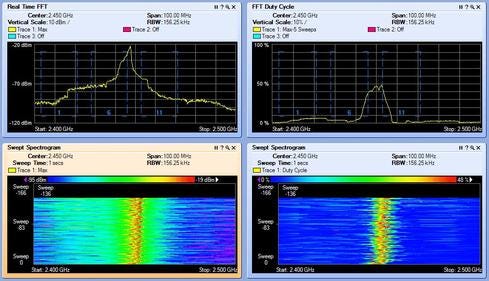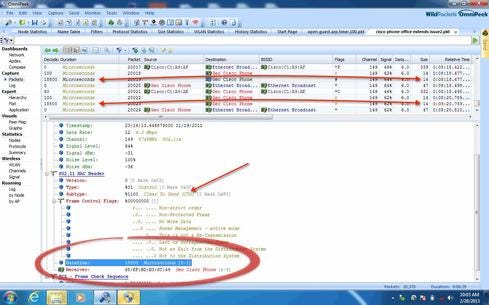No WLAN engineer’s tool box is complete without spectrum and protocol analyzers. Here’s why.

We’ve come a long way since Netstumber and Kismet were the all-purpose tools for identifying, and in some cases surveying and troubleshooting, Wi-Fi networks. These days, network engineers and administrators have a wide range of options, from freeware to very expensive enterprise tools. What’s in your Wi-Fi tool box? What needs to be there?
In my opinion, you need two categories of products for everyday use: spectrum analyzers and protocol analyzers. That’s because Wi-Fi operates at two layers in the OSI model, the physical layer and the data layer. Specific tools are required to interact with each of these layers.
The physical layer takes information from the upper layers in the OSI model and transforms data into bits. These bits are transmitted differently depending on the medium and modulation used.
In the wired world, the physical layer includes wires, fiber and Gigabit Interface Converters (GBICs). In the wireless world, the physical layer is radio frequency (RF). This is where bits are used in complex spreading mechanisms such as BPSK, QPSK, and QAM256 (802.11ac), and then transmitted over equally complex modulations such as DSSS, HR-DSSS, OFDM and MIMO-OFDM.
Wi-Fi spectrum analyzers examine the physical layer of RF; spectrum analyzers are RF glasses that peer into a medium you wouldn’t otherwise see.
Wi-Fi is an unlicensed medium operating in the 2.4GHz and 5GHz bands. Unlicensed RF space can be problematic. Microwave ovens, Bluetooth headsets, baby monitors, cordless phones and many more devices operate in the same frequency bands as Wi-Fi. These devices cause interference with Wi-Fi communications, which results in data retires and loss. An unassuming Wi-Fi user interprets interference as a slow or a broken Wi-Fi connection and has a poor impression of network performance.
Sometimes interference is elusive; it comes and goes, leaving frustrated users frustrated in its wake. A spectrum analyzer in capable hands can identify interference.
The image below, from the Cisco Spectrum Expert product, is an example of a microwave oven as seen through a spectrum analyzer. The analyzer provides key data points, including Real Time FFT and FFT Duty Cycle.
Real Time FFT represents the power of the signal generated by the microwave oven, in this case the interference. The spectrum analyzer reports -20 dBm, which means we’re in very close proximity of the microwave oven. This is very helpful information. We can use this reading to locate interference. We can also interpret how loud the interference is and the area it may affect.

FFT Duty Cycle represents a percentage of time the RF signal is 20 dB above the noise floor. In other words, it acts as a form of channel utilization. In this case, the microwave oven is using almost 50% of the channel. You can also see the back end of channel 6 and the beginning of channel 11 are affected.
A user associated to an access point in this area on channel 6 or 11 could experience poor performance when the microwave is in operation.
Not all Wi-Fi spectrum analyzer are created equal. A top-shelf Wi-Fi analyzer provides, among other features, automated signatures, remote spectrum sensor capturing, and data import into survey and wireless control system software.
I’m a fan of the lower-cost spectrum analyzers. They provide similar level of consistency as the more expensive products and report Real Time FFT and Duty Cycle, which are important, though you get fewer bells and whistles.
The Data Layer
In addition to the physical layer, wireless engineers and administrators have to concern themselves with the data layer. This requires a protocol analyzer. The 802.11 protocol is complex. It can use up to four fields, including Source Address, Destination Address, Transmit Address, and Receive address. In most cases, 802.11 only uses three address fields, except WDS or MESH, which use all four.
802.11 uses three types of frames: Management, Control and Data. Management frames establish and maintain a connection between the client and access point. Control frames help facilitate the delivery of data fames. Data frames transmit data (with the exception of the Null data frame).
A protocol analyzer, also called a sniffer, lets you to capture wireless frames. This aids with troubleshooting and helps you evaluate and baseline wireless devices during testing. A protocol analyzer also lets you to see and capture the 802.11 conversation between devices. A protocol analyzer in experienced hands can quickly determine if a device isn’t behaving as it should.
Below is an example of a device behaving badly and causing a poor user experience as seen via a protocol analyzer from WildPackets. Without protocol analyzer we would have no visibility of this problem.

In this specific case, a radio was sending a NAV timer duration of 18,800 microseconds. This was causing all clients on channel to pause for an extended period of time. This resulted in poor user performance. In this case, the issue was a software bug.
There’s a number of protocol analyzers on the market today, with prices ranging from free to a few thousand dollars. Paid products tend to provide user support, software upgrades, statistics, built-in analysis and an assortment of wireless NIC options. Freeware options tend to be Linux-based and will have a learning curve for non-Linux folks during setup.
Where To Start?
Engineers often purchase expensive spectrum and protocol analyzers with the assumption that the more sophisticated the tool, the faster it will resolve the problem. While a sophisticated tool will give you more features and functions, it can also add complexity, user frustration and ultimately cause disappointment. On the flip side, free and low-cost tools may not have all the features you need for the job, or lack support.
Which ones are right for you? The answer depends on a variety of factors, including the size and complexity of your environment, the problems you need to address, the experience of your staff and your budget.
Stop by my Interop session, The Wireless Engineer’s Essential Toolkit, where I’ll cover in detail an assortment of products and give you options and recommendations for your Wi-Fi tool box. In the meantime, what tools do you find invaluable? You can use the comments section to share your favorites.
About the Author(s)
You May Also Like







